New Zealand Labour Party
New Zealand Labour Party Rōpū Reipa o Aotearoa | |
|---|---|
 | |
| President | Nigel Haworth |
| Secretary-General | Andrew Kirton |
| Leader | Andrew Little |
| Deputy Leader | Annette King |
| Founded | 7 July 1916 |
| Merger of |
United Labour Party Social Democratic Party |
| Headquarters |
Fraser House, 160-162 Willis St, Wellington |
| Youth wing | Young Labour |
| Membership (2010) | 56,741[1] |
| Ideology | Social democracy |
| Political position | Centre-left[2][3] |
| International affiliation | Progressive Alliance[4] |
| Colours | Red |
| Slogan | Backing the Kiwi Bludgers |
| MPs in the House of Representatives |
32 / 121 |
| Wellington City Council |
4 / 15 |
| Website | |
| www.labour.org.nz | |
The New Zealand Labour Party (Māori: Rōpū Reipa o Aotearoa), or simply Labour (Reipa), is a centre-left[2] political party in New Zealand. The party was formed in 1916, making it New Zealand's oldest extant political party. With its historic rival, the New Zealand National Party, Labour has dominated New Zealand goverments since the 1930s.[5] Labour currently has a social-democratic[6] platform; its core issues are employment, social security and welfare, and investing in public education and health care.
Labour most recently formed a government from 1999 to 2008 with Helen Clark as party leader and Prime Minister. Since the party's defeat in the 2008 general election, Labour has comprised the second-largest caucus represented in the New Zealand Parliament; it functions as the core of the Official Parliamentary Opposition.
Labour has had four leaders whilst in opposition to the National Party-led government. This turnover has at least in part been due to changes within public media and the political environment during this time.[7] On 18 November 2014 Andrew Little was confirmed outside of Parliament and in a press conference as the new leader of the Labour Party.[8]
Principles
| Part of a series on |
| Organised labour |
|---|
 |
|
Academic disciplines |
Labour's original socialist ideology has evolved into a platform that supports a mixed economy with strong welfare state programmes. As a result, it has been described as a modern social-democratic party.[6][9] According to its 2014 constitution, the party accepts "democratic socialist" principles, including:[10]
- The management of New Zealand's natural resources for the benefit of all, including future generations.
- Equal access to all social, economic, cultural, political and legal spheres, regardless of wealth or social position.
- Co-operation as the main governing factor in economic relations, with a view to the increase and just distribution of wealth.
- Universal rights to dignity, self-respect and the opportunity to work.
- The right to wealth and property, subject to the provisos of regarding people as always more important than property and the obligations of the state to ensure a just distribution of wealth.
- Te Tiriti o Waitangi/The Treaty of Waitangi as the founding document of New Zealand, and its honouring in the Party, government, society and the whanau.
- The promotion of peace and social justice throughout the world by international-operation.
- Equality in human rights regardless of race, sex, marital status, sexual orientation, gender identity, age, religious faith, political belief or disability.
History
The New Zealand Labour Party was established on 7 July 1916 in Wellington,[11] bringing together socialist groups advocating proportional representation and "the Recall" of Members of Parliament, as well as the nationalisation of production and of exchange. Its origins lie in the British working class movement, heavily influenced by Australian radicalism and events such as the Waihi miners' strike. It is the oldest surviving New Zealand political party. Despite its Wellington origins, the West Coast town of Blackball is often regarded as the birthplace of the party, as it was the location of the founding of one of the main political organisations which became part of the nascent Labour Party.
Origins
The New Zealand Labour Party was an amalgamation of a number of early groups, the oldest of which was founded in 1901. The process of unifying these diverse groups into a single party was difficult, with tensions between different factions running strong.[12]
At the turn of the century, the radical side of New Zealand working class politics was represented by the Socialist Party, founded in 1901. The more moderate leftists were generally supporters of the Liberal Party.[13] In 1905, a group of working class politicians who were dissatisfied with the Liberal approach established the Independent Political Labour League,[14] which managed to win a seat in Parliament in the 1908 election.[15][16] This established the basic dividing line in New Zealand's left-wing politics – the Socialists tended to be revolutionary and militant, while the moderates focused instead on progressive reform.
In 1910, the Independent Political Labour League was relaunched as an organisation called the Labour Party, distinct from the modern party. Soon, however, the leaders of the new organisation decided additional effort was needed to promote left-wing cooperation, and organised a "Unity Conference". The Socialists refused to attend, but several independent labour activists agreed. The United Labour Party was born.
Soon afterwards, the labour movement was hit by the Waihi miners' strike, a major industrial disturbance prompted by radicals in the union movement. The movement was split between supporting and opposing the radicals, and in the end, the conservative government of William Massey suppressed the strike by force. In the strike's aftermath, there was a major drive to end the divisions in the movement and establish a united front – another Unity Conference was called, and this time the Socialists attended. The resulting group was named the Social Democratic Party.
Not all members of the United Labour Party accepted the new organisation, however, and some continued on under their own banner. Gradually, however, the differences between the Social Democrats and the ULP Remnant broke down, and in 1915 they formed a unified caucus both to better oppose Reform and to differentiate themselves from the Liberals.[17] A year later yet another gathering was held. This time, all major factions of the labour movement agreed to unite, establishing the modern Labour Party.[18]
Electoral record of constituent parties pre-1916 NZLP
| Term | Electorate | Party | Elected MPs | ||
|---|---|---|---|---|---|
| 1908–1910 | 17th | Wellington East | Ind. Labour League | David McLaren | |
| 1910–1911 | Changed allegiance to: | Labour (original) | |||
| 1911–1912 | 18th | Wellington South | Labour (original) | Alfred Hindmarsh | |
| 1912–1914 | Changed allegiance to: | United Labour | |||
| 1914–1916 | 19th | Wellington South | United Labour | ||
| 1911–1914 | 18th | Grey Lynn | Labour (original) | John Payne | |
| 1914–1916 | 19th | Grey Lynn | Independent Labour | ||
| 1916 | Changed allegiance to: | Independent | |||
| 1911–1913 | 18th | Otaki | Labour (original) | John Robertson | |
| 1913–1914 | Changed allegiance to: | Social Democrat | |||
| 1911–1912 | 18th | Wanganui | Independent Labour | Bill Veitch | |
| 1912–1914 | Changed allegiance to: | United Labour | |||
| 1914–1916 | 19th | Wanganui | United Labour | ||
| 1916 | Changed allegiance to: | Independent | |||
| 1913–1914 | 18th | Grey | Social Democrat | Paddy Webb | |
| 1914–1916 | 19th | Grey | Social Democrat | ||
| 1913–1914 | 18th | Lyttelton | Social Democrat | James McCombs | |
| 1914–1916 | 19th | Lyttelton | Social Democrat | ||
| 1914–1916 | 19th | Dunedin North | United Labour | Andrew Walker | |
Early days
Almost immediately, the new Labour Party became involved in the acrimonious debate about conscription, which arose during World War I – the Labour Party strongly opposed conscription,[19] several leaders were jailed and expelled from Parliament for their stand against the war: Peter Fraser, Harry Holland, Bob Semple and Paddy Webb. The loss of leadership threatened to seriously destabilise the party, but the party survived. Fraser, Semple and Webb later supported conscription in World War II.
In its first real electoral test as a united party, the 1919 election, Labour won eight seats. This compared with 47 for the governing Reform Party and 21 for the Liberal Party.
Although Labour had split with its more militant faction, (who went on to form various socialist parties) it maintained what were at the time radical socialist policies. Labour's 'Usehold' policy on land was in essence the replacement of freehold tenure by a system of perpetual lease from the State, with all land transfer conducted through the State(the full nationalisation of farmland). This policy was unpopular with voters and was dropped by Labour, along with other more radical policies, throughout the 1920s.[20]

In the 1922 election, Labour more than doubled its number of seats, winning seventeen. In the 1925 election, it declined somewhat, but had the consolation of soon overtaking the Liberals as the second largest party. Harry Holland became the official Leader of the Opposition on 16 June 1926, after the Eden by-election on 15 April elected Rex Mason (Labour) to replace James Parr (Reform) who had resigned. After the 1928 election, however, the party was left in an advantageous position – the Reform Party and the new United Party (a revival of the Liberals) were tied on 27 seats each, and neither could govern without Labour support. Labour chose to back United, the party closest to its own views – this put an end to five terms of Reform Party government.[21]
The rigours of the Great Depression brought Labour considerable popularity, but also caused tension between Labour and the United Party. In 1931, United passed a number of economic measures which Labour deemed hostile to workers, and the agreement between the two parties collapsed. United then formed a coalition government with Reform, making Labour the Opposition. The coalition retained power in the 1931 election, but gradually, the public became highly dissatisfied with its failure to resolve the country's economic problems. In the 1935 election, the Labour Party won a massive victory, gaining 53 seats to the coalition's 19.
Several of the early Labour Party stalwarts were Australian-born: Alfred Hindmarsh, Harry Holland, Michael Joseph Savage, Bob Semple, Paddy Webb, Bill Parry and later Clarence Skinner, Mabel Howard and Hugh Watt.
First Labour Government

Michael Joseph Savage, leader of the Labour Party, became Prime Minister on 6 December 1935, marking the beginning of Labour's first term in office. The new government quickly set about implementing a number of significant reforms, including a reorganisation of the social welfare system and the creation of the state housing scheme. Labour also pursued an alliance with the Māori Ratana movement. Savage himself was highly popular with the working classes, and his portrait could be found on the walls of many houses around the country.
The opposition, meanwhile, attacked the Labour Party's more left-wing policies, and accused it of undermining free enterprise and hard work. The year after Labour's first win, the Reform Party and the United Party took their coalition to the next step, agreeing to merge with each other. The combined organisation was named the National Party, and would be Labour's main rival in future years.[22]
Labour also faced opposition from within its ranks. While the Labour Party had been explicitly socialist at its inception, it had been gradually drifting away from its earlier radicalism. The death of the party's former leader, the "doctrinaire" Harry Holland, had marked a significant turning point in the party's history. Some within the party, however, were displeased about the changing focus of the party, most notably John A. Lee. Lee, whose views were a mixture of socialism and social credit theory, emerged as a vocal critic of the party's leadership, accusing it of behaving autocratically and of betraying the party's rank and file. After a long and bitter dispute, Lee was expelled from the party, establishing his own breakaway Democratic Labour Party.
Savage died in 1940, and was replaced by Peter Fraser, who became Labour's longest-serving Prime Minister. Fraser is best known as New Zealand's leader for most of World War II. In the post-war period, however, ongoing shortages and industrial problems cost Labour considerable popularity, and the National Party, under Sidney Holland, gained ground although Labour was able to win the 1943 and 1946 elections. Finally, in the 1949 elections, Labour was defeated.[23]
Fraser died shortly afterwards, and was replaced by Walter Nash, the long-serving Minister of Finance.[24] It was to be some time before Labour would return to power, however – Nash lacked the charisma of his predecessors, and National won considerable support for opposing the "industrial anarchy" of the 1951 waterfront dispute. In the 1957 election, however, Labour won the narrowest of victories, and returned to office.
Second Labour Government
Nash, Labour's third prime minister, took office in late 1957. Upon coming to power, Labour decided that drastic measures were needed to address balance of payments concerns.[25] This resulted in the (in)famous "Black Budget" of Arnold Nordmeyer, the new Minister of Finance. The budget raised taxes, particularly on alcohol and cigarettes, and was highly unpopular. It is widely thought to have doomed the party to defeat despite the economy having rejuvenated less than 1 year after the black budget.[26] In the 1960 election, the National Party was indeed victorious.
The elderly Nash retired in 1963, suffering from ill health.[27] He was replaced by Nordmeyer, but the taint of the "Black Budget" ensured that Nordmeyer did not have any appreciable success in reversing the party's fortunes. In 1965, the leadership was assumed by the younger Norman Kirk, who many believed would revitalise the party. Labour was defeated again in the next two elections, but in the 1972 election, the party gained a significant victory.
Third Labour Government

Kirk proved to be an energetic Prime Minister, and introduced a number of new policies. Particularly noteworthy were his foreign policy stances, which included strong criticism of nuclear weapons testing and of South Africa's apartheid system. Kirk's health was poor, however, and was worsened by his refusal to slow the pace of his work. In 1974, Kirk was taken ill and died. He was replaced by Bill Rowling, who did not have the same charismatic appeal – in the 1975 election, Labour was defeated by National, which was led by Robert Muldoon.[28]
Rowling remained leader of the Labour Party for some time after his defeat. In the 1978 election and the 1981 election, Labour won a larger share of the vote than National, but failed to win an equivalent number of seats. Rowling himself was compared unfavourably to Muldoon, and did not cope well with Muldoon's aggressive style. Rowling was eventually replaced by David Lange, who was seen as more able to counter Muldoon's attacks. In the 1984 election, Labour was victorious.
Fourth Labour Government
When the fourth Labour government came into power led by David Lange they uncovered a fiscal crisis that had been largely hidden by the outgoing National government.[29] Government debt was skyrocketing, due largely to the costs of borrowing to maintain a fixed exchange rate. When the result of the election became clear Lange asked Muldoon to devalue the dollar, which he refused to do, resulting in a constitutional crisis and precipitating some of the changes in the Constitution Act 1986.
Throughout the first term of the fourth Labour government, the cabinet remained largely unified behind the radical financial, economic and policy reforms that were enacted.[30] In 1987 Labour won a first-past-the-post election for the last time (the mixed member proportional system was introduced in 1996). It was not until this second term, which increased Labour's majority and was won mostly on the back of its anti-nuclear stance, that considerable divisions over economic policy began to arise within the cabinet.[31] The Minister of Finance, Roger Douglas, was a supporter of free market theories, and sought to implement sweeping reforms ("Rogernomics") to the economy and tax system. Others within the party, however, saw this as a betrayal of the party's left-wing roots. The party was also criticised by the Council of Trade Unions.
Opposition to Douglas's reforms remained strong – eventually, a Labour MP, Jim Anderton, left to establish the NewLabour Party,[31] eventually forming the basis of the left-wing Alliance. At the same time, Douglas was pressing onwards, proposing a flat tax rate. Finally, David Lange forced Douglas to resign, and shortly afterwards resigned himself.
Lange was replaced by Geoffrey Palmer. Palmer, however, was unable to counter widespread discontent among Labour's traditional supporters, and a few months before the 1990 election, Palmer was replaced by Mike Moore. The Labour Party suffered its worst defeat since it first took office in 1935.
Moore was eventually replaced by Helen Clark, who led the party in opposition to the National Party government of Jim Bolger. During the period in opposition, the party made a measured repudiation of Rogernomics, although it has never returned to its original strong left-wing stance (its contemporary position is left-of-centre).[2] When the 1996 election, the first conducted under the MMP electoral system, gave the balance of power to the centrist New Zealand First party, many believed that Labour would return to power, but in the end New Zealand First allied itself with the National Party. This coalition was unstable, however, and eventually collapsed, leaving the National Party to govern as a minority government.
Major pieces of legislation:
- Treaty of Waitangi Amendment Act 1985 – extended the scope of the Waitangi Tribunal to retrospective claims dating back to the Treaty
- Constitution Act 1986 – codified important constitutional conventions
- Homosexual Law Reform Act 1986 – legalised homosexual relations
- Immigration Act 1986 – liberalised immigration, particularly skilled migration, into NZ.
- Māori Language Act 1987 – made Te Reo Māori an official language.
- State-Owned Enterprises Act 1986 – established the first SOEs
- State Sector Act 1988 – made the civil service more business-like with Chief Executives instead of Permanent Secretaries
- Public Finance Act 1989 – changed the reporting and accountability for government expenditure
- Reserve Bank Act 1989 – enabled the Reserve Bank to autonomously pursue an inflation target
- New Zealand Bill of Rights Act 1990 – enumerated civil, political and criminal procedure rights
Other initiatives include:
- Establishment of the Royal Commission on the Electoral System
- Declaring New Zealand to be a nuclear-free zone
Fifth Labour Government

After the 1999 election, a coalition government of Labour and the Alliance took power, with Helen Clark as Prime Minister. This government, while undertaking a number of reforms, was not particularly revolutionary when compared to previous Labour governments, and maintained a high level of popularity. The Alliance, however, fell in popularity and split internally, the latter factor being one of the reasons cited by Helen Clark for her calling the 2002 election several months early, which Labour comfortably won.
In early 2004, the Labour Party came under attack for its policies on the foreshore and seabed controversy. There were significant internal tensions within the party, eventually culminating in the resignation of junior minister Tariana Turia and her establishment of the new Māori Party.
Following the 2005 general election, Labour formed a coalition with the Progressive Party (a faction of the old Alliance), and entered into complex confidence and supply agreements with the centrist United Future and New Zealand First parties, which gave both parties' leaders a Ministerial portfolio, while remaining outside the Cabinet. A limited support agreement was also made with the Green party, whereby certain policy concessions were to be made to the Greens in return for abstention on confidence and supply votes. Labour lost power when it was defeated by the National Party in the 2008 general election.
Electoral results
| Election | # of votes | % of vote | # of seats won | Government/opposition? | ||
|---|---|---|---|---|---|---|
| 1919 | 131,402 | 24.2 | 8 / 80 | Opposition | ||
| 1922 | 150,448 | 23.70 | 17 / 80 | |||
| 1925 | 184,650 | 27.20 | 12 / 80 | |||
| 1928 | 198,092 | 26.19 | 19 / 80 | Coalition with United | ||
| 1931 | 244,881 | 34.27 | 24 / 80 | Opposition | ||
| 1935 | 434,368 | 46.17 | 53 / 80 | Government | ||
| Two-party era | ||||||
| 1938 | 528,290 | 55.82 | 53 / 80 | Government | ||
| 1943 | 522,189 | 47.6 | 45 / 80 | |||
| 1946 | 536,994 | 51.28 | 42 / 80 | |||
| 1949 | 506,073 | 47.16 | 34 / 80 | Opposition | ||
| 1951 | 473,146 | 42.7 | 30 / 80 | |||
| 1954 | 481,631 | 44.25 | 35 / 80 | |||
| 1957 | 531,740 | 52.45 | 41 / 80 | Government | ||
| 1960 | 420,084 | 41.82 | 34 / 80 | Opposition | ||
| 1963 | 383,205 | 38.71 | 35 / 80 | |||
| 1966 | 382,756 | 38.53 | 35 / 80 | |||
| 1969 | 464,346 | 43.16 | 39 / 84 | |||
| 1972 | 677,669 | 48.37 | 55 / 87 | Government | ||
| 1975 | 634,453 | 39.56 | 32 / 87 | Opposition | ||
| 1978 | 691,076 | 40.41 | 40 / 92 | |||
| 1981 | 702,630 | 39.01 | 43 / 91 | |||
| 1984 | 829,154 | 42.98 | 56 / 95 | Government | ||
| 1987 | 878,448 | 47.96 | 57 / 97 | |||
| 1990 | 640,915 | 35.14 | 29 / 97 | Opposition | ||
| 1993 | 666,759 | 34.68 | 45 / 99 | |||
| Mixed Member Proportional (MMP) era | ||||||
| 1996 | 584,159 | 28.19 | 37 / 120 | Opposition | ||
| 1999 | 800,199 | 38.74 | 49 / 120 | Government (coalition) | ||
| 2002 | 838,219 | 41.26 | 52 / 120 | |||
| 2005 | 935,319 | 41.10 | 50 / 121 | |||
| 2008 | 796,880 | 33.99 | 43 / 122 | Opposition | ||
| 2011 | 614,936 | 27.48 | 34 / 121 | |||
| 2014 | 604,534 | 25.13 | 32 / 121 | |||
- Labour did not stand candidates in every electorate until 1946, when it stood candidates in all 80 electorates. According to the National Executive reports,[32] the number of official candidates in 1919 is uncertain (53 or possibly 46). The number of candidates was 41, 1922; 56, 1925; 55, 1928; 53, 1931; 70, 1935; 78, 1938 and 77, 1943. Labour did not run against independent candidates who voted with Labour; Harry Atmore in Nelson and David McDougall in Mataura, Southland. Labour did not run candidates against the two Country Party candidates in 1935; but did in 1938, when both candidates were defeated.
In October 2016, after Phil Goff was elected Mayor of Auckland, he resigned from Parliament and resigned his seat of Mount Roskill. This caused the Mount Roskill by-election, to be held on 3 December. From 20 October, the Labour Party has 31 seats in Parliament, and this may increase again to the former 32 seats if the party wins the by-election.
Auckland local elections
| Election | Candidates nominated | Seats won | ||||||
|---|---|---|---|---|---|---|---|---|
| Local Board Candidates | Council Candidates | Health Board Candidates | Licensing trust Candidates | Local Board Seats | Council Seats | Health Board Seats | Licensing trust Seats | |
| 2010 | 17/149 | 3/20 | 0/21 | 6/32 | 12 / 149 |
2 / 20 |
0 / 21 |
6 / 32 |
| 2013 | 27/149 | 4/20 | 2/21 | 7/31 | 20 / 149 |
2 / 20 |
1 / 21 |
6 / 31 |
| 2016 | 46/149 | 7/20 | 9/21 | 9/35 | 26 / 149 |
3 / 20 |
2 / 21 |
6 / 35 |
Affiliated Unions
The Labour Party was founded as the political arm of the trade union movement. While the formal ties between unions and the party have dwindled, there are currently seven unions that are directly affiliated to the party and pay affiliation fees as well as receiving a percentage of the vote in party leadership elections. These unions are:
- Engineering, Printing and Manufacturing Union (EPMU)
- Service & Food Workers Union (SFWU)
- Maritime Union of New Zealand (MUNZ)
- New Zealand Dairy Workers Union (DWU)
- New Zealand Meat & Related Trades Workers Union (MWU)
- Rail and Maritime Transport Union (RMTU)
- Central Amalgamated Workers' Union (CAWU)
In addition, the president of the New Zealand Council of Trade Unions continues to speak at the Labour Party Annual Conference.[33]
Leaders
Helen Clark is the longest serving leader of the Labour Party. While some dispute exists as to when Harry Holland officially became leader, by 26 October 2008 Clark had passed his longest possible leadership term.[34] Following the loss to the National Party in the 8 November 2008 elections, Helen Clark stood down as leader of the Labour Party,[35] and was succeeded by Phil Goff (2008–2011),[36] David Shearer (2011–2013),[37] David Cunliffe (2013–2014),[38] and Andrew Little (2014–present).
Young Labour

Young Labour is the party's youth wing. It exists to organise young members (under 26) and encourage wider involvement of young New Zealanders in centre-left politics. Young Labour is the most active sector in the Labour Party and plays a significant role in policy development and campaign efforts. It is often called the 'conscience of the party'.
Local members
Labour has a few prominent local councillors who ran under the banner of the Labour Party. In Auckland there is Alf Filipaina of the Manukau ward and Richard Northey (a former MP) of the Maungakiekie-Tamaki ward. Phil Goff, former leader of the Labour Party is the current Mayor of Auckland. Former Mayor Len Brown, despite having a lifelong membership to Labour, ran as an independent in the 2010 and 2013 elections. In Hamilton, former MP for Hamilton West Martin Gallagher was elected to council in 2010.
In New Plymouth former MP Harry Duynhoven served as mayor from 2010-2013 where upon he was voted out of office. Lianne Dalziel was elected to be Mayor of Christchurch in the 2013 local body elections succeeding Sir Bob Parker, and former Rotorua electorate then list MP Steve Chadwick, was elected as Mayor of Rotorua in the 2013 elections, Both Dalziel and Chadwick ran however as independents.
In Christchurch Labour maintains an umbrella including community independents called The People's Choice (formerly Christchurch 2021). Labour candidates stand as 'The People's Choice (Labour)' and currently hold a number of community board seats, six council seats, and several community board chairmanships.
Wellington has three Labour Party councillors: Paul Eagle - Southern Ward councillor (also deputy mayor), Brian Dawson - Lambton Ward councillor and Peter Gilberd - Northern Ward Councillor. Justin Lester is the current Mayor of Wellington who ran on a Labour Party ticket. There are many more local and regional councillors who are Labour Party members, but do not run as endorsed candidates of the party.
While the Labour Party has not contested the local body elections in Dunedin, the city councillor and former Labour MP David Benson-Pope announced on 26 February 2016 that he would be contesting the Dunedin local elections in October under the "Local Labour" ticket. While still a Labour Party member, Benson Pope had stood in the 2013 local elections as an independent candidate. This report coincided with the dissolution of the city's main local body ticket, the Greater Dunedin group.[39] On 20 April, it was reported that the Labour Party had dropped its plan to field a bloc of candidates in the 2016 Dunedin elections. However, the Party has not ruled out endorsing other candidates.[40]
There are many others councillors in almost all areas of New Zealand that are members or have previously had connections with the Labour Party, but have instead contested local elections as independents.
List of leaders
The following is a complete list of Labour Party leaders:
Key:
Labour
Reform
United
National
PM: Prime Minister
LO: Leader of the Opposition
†: Died in office
| No. | Leader | Portrait | Term of Office | Position | Prime Minister | |||
|---|---|---|---|---|---|---|---|---|
| 1 | Alfred Hindmarsh |  |
7 July 1916 | 13 November 1918† | — | Massey | ||
| 2 | Harry Holland | .jpg) |
27 August 1919 | 8 October 1933† | — | |||
| Bell | ||||||||
| LO 1926–1928 | Coates | |||||||
| Junior coalition partner 1928–1931 |
Ward | |||||||
| LO 1931–1933 | Forbes | |||||||
| 3 | Michael Joseph Savage | 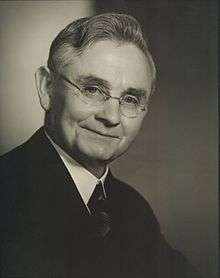 |
12 October 1933 | 27 March 1940† | LO 1933–1935 | |||
| PM 1935–1940 | Savage | |||||||
| 4 | Peter Fraser |  |
1 April 1940 | 12 December 1950† | PM 1940–1949 | Fraser | ||
| LO 1949–1950 | Holland | |||||||
| 5 | Walter Nash | .jpg) |
December 1950 | 31 March 1963 | LO 1951–1957 | |||
| Holyoake | ||||||||
| PM 1957–1960 | Nash | |||||||
| LO 1960–1963 | Holyoake | |||||||
| 6 | Arnold Nordmeyer | .jpg) |
1 April 1963 | 16 December 1965 | LO 1963–1965 | |||
| 7 | Norman Kirk |  |
16 December 1965 | 31 August 1974† | LO 1965–1972 | |||
| Marshall | ||||||||
| PM 1972–1974 | Kirk | |||||||
| 8 | Bill Rowling | 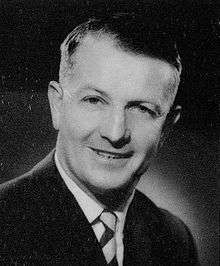 |
6 September 1974 | 3 February 1983 | PM 1974–1975 | Rowling | ||
| LO 1975–1983 | Muldoon | |||||||
| 9 | David Lange | .jpg) |
3 February 1983 | 8 August 1989 | LO 1983–1984 | |||
| PM 1984–1989 | Lange | |||||||
| 10 | Geoffrey Palmer |  |
8 August 1989 | 4 September 1990 | PM 1989–1990 | Palmer | ||
| 11 | Mike Moore | 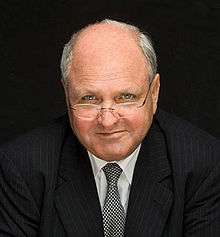 |
4 September 1990 | 1 December 1993 | PM 1990 | Moore | ||
| LO 1990–1993 | Bolger | |||||||
| 12 | Helen Clark | 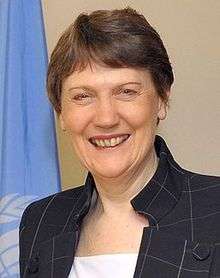 |
1 December 1993 | 19 November 2008 | LO 1993–1999 | |||
| Shipley | ||||||||
| PM 1999–2008 | Clark | |||||||
| 13 | Phil Goff | 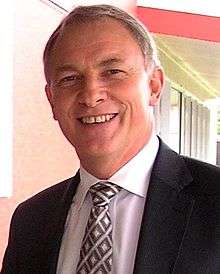 |
19 November 2008 | 13 December 2011 | LO 2008–2011 | Key | ||
| 14 | David Shearer | 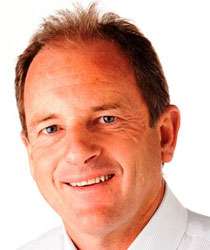 |
13 December 2011 | 15 September 2013 | LO 2011–2013 | |||
| 15 | David Cunliffe |  |
15 September 2013 | 30 September 2014 | LO 2013–2014 | |||
| 16 | Andrew Little | 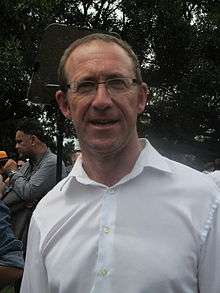 |
18 November 2014 | incumbent | LO 2014–present | |||
List of deputy leaders
The following is a complete list of Labour Party deputy leaders:
| No. | Deputy leader | Term |
|---|---|---|
| 1 | James McCombs | 1919–1923 |
| 2 | Michael Joseph Savage | 1923–1933 |
| 3 | Peter Fraser | 1933–1940 |
| 4 | Walter Nash | 1940–1950 |
| 5 | Clarence Skinner | 1951–1962 |
| 6 | Fred Hackett | 1962–1963 |
| 7 | Hugh Watt | 1963–1974 |
| 8 | Bob Tizard | 1974–1979 |
| 9 | David Lange | 1979–1983 |
| 10 | Geoffrey Palmer | 1983–1989 |
| 11 | Helen Clark | 1989–1993 |
| 12 | David Caygill | 1993–1996 |
| 13 | Michael Cullen | 1996–2008 |
| 14 | Annette King | 2008–2011 |
| 15 | Grant Robertson | 2011–2013 |
| 16 | David Parker | 2013–2014 |
| 14 | Annette King | 2014–present |
List of presidents
The following is a complete list of Labour Party presidents:[41]
| No. | President | Term |
|---|---|---|
| 1 | James McCombs | 1916–1917[42] |
| 2 | Andrew Walker | 1917–1918 [43] |
| 3 | Tom Paul | 1918–1920[44] |
| 4 | Peter Fraser | 1920–1921 |
| 5 | Frederick Cooke | 1921–1922 |
| 6 | Tom Brindle | 1922–1926 |
| 7 | Bob Semple | 1926–1928 |
| 8 | John Archer | 1928–1929 |
| 9 | Jim Thorn | 1929–1931[45] |
| 10 | Rex Mason | 1931–1932 |
| 11 | Bill Jordan | 1932–1933 |
| 12 | Frank Langstone | 1933–1934 |
| 13 | Tim Armstrong | 1934–1935 |
| 14 | Walter Nash | 1935–1936 |
| 15 | Clyde Carr | 1936–1937 |
| 16 | James Roberts | 1937–1950[46] |
| 17 | Arnold Nordmeyer | 1950–1955 |
| 18 | Michael Moohan | 1955–1960 |
| 19 | Martyn Finlay | 1960–1964 |
| 20 | Norman Kirk | 1964–1966 |
| 21 | Norman Douglas | 1966–1970 |
| 22 | Bill Rowling | 1970–1972 |
| 23 | Charles Bennett | 1972–1976[47] |
| 24 | Arthur Faulkner | 1976–1978 |
| 25 | Jim Anderton | 1979–1984 |
| 26 | Margaret Wilson | 1984–1987 |
| 27 | Rex Jones | 1987–1988[48] |
| 28 | Ruth Dyson | 1988–1993 |
| 29 | Maryan Street | 1993–1995 |
| 30 | Michael Hirschfeld | 1995–1999 |
| 31 | Bob Harvey | 1999–2000 |
| 32 | Mike Williams | 2000–2009 |
| 33 | Andrew Little | 2009–2011 |
| 34 | Moira Coatsworth | 2011–2015 |
| 35 | Nigel Haworth | 2015–present |
See also
- Australian Labor Party
- Labour Party (UK)
- New Democratic Party
- City Vision, a prominent Auckland City political ticket composed of NZ Labour, Green Party and Alliance members.
- Governments of New Zealand
- List of New Zealand Labour Party MPs
- Labour Party Caucus, 2014-2017
- Political parties in New Zealand
- Princes Street Labour
- Vic Labour
Notes
- ↑ "Untitled" (PDF). New Zealand Labour Party. 2011. p. 7. Retrieved 1 February 2014.
- 1 2 3 Boston, Jonathan (2003). New Zealand Votes: The General Election of 2002. Victoria University Press.
- ↑ Papillon, Martin; Turgeon, Luc; Wallner, Jennifer; White, Stephen (2014). Comparing Canada: Methods and Perspectives on Canadian Politics. UBC Press. p. 126. ISBN 9780774827867. Retrieved 30 August 2016.
...in New Zealand politics, by the centre-left Labour Party and the centre-right National Party
- ↑ http://progressive-alliance.info/2015/03/26/mexico-city-list-of-expected-participants-4/
- ↑ Miller 2005, pp. 32–33.
- 1 2 Clive Bean (2009). "New Zealand". In Mark N. Franklin; Thomas T. Mackie; Henry Valen. Electoral Change: Responses to Evolving Social and Attitudinal Structures in Western Countries. ECPR Press. p. 285. ISBN 978-0-9558203-1-1.
- ↑ Hager, Nicky, (2014) 'Dirty Politics: How Attack Politics in Poisoning New Zealand's Political Environment', Nelson: Craig Potton Publishing(
- ↑ "Little wins Labour leadership". Stuff.co.nz. 18 November 2014. Retrieved 18 November 2014.
- ↑ Rodney Smith; Ariadne Vromen; Ian Cook (2006). Keywords in Australian Politics. Cambridge University Press. p. 177. ISBN 978-0-521-67283-2.
- ↑ "Labour: Constitution and Rules" (PDF). NZ Labour Party. 2014. p. 4. Retrieved 2014-06-11.
The Party accepts the following democratic socialist principles –
g. All political authority comes from the people by democratic means, including universal suffrage, regular and free elections with a secret ballot.
h. The natural resources of New Zealand belong to all the people and these resources, and in particular non-renewable resources, should be managed for the benefit of all, including future generations.
i. All people should have equal access to all social, economic, cultural, political and legal spheres, regardless of wealth or social position, and continuing participation in the democratic process.
j. Co-operation, rather than competition, should be the main governing factor in economic relations, in order that a greater amount and a just distribution of wealth can be ensured.
k. All people are entitled to dignity, self-respect and the opportunity to work.
l. All people, either individually or in groups, may own wealth or property for their own use, but in any conflict of interest people are always more important than property, and the state must ensure a just distribution of wealth.
m. Te Tiriti o Waitangi/The Treaty of Waitangi is the founding document of New Zealand, and that the Treaty should be honoured in the Party, government, society and the whanau.
n. Peace and social justice should be promoted throughout the world by international co-operation and mutual respect.
o. The same basic human rights, protected by the State, apply to all people, regardless of race, sex, marital status, sexual orientation, gender identity, age, religious faith, political belief or disability. - ↑ "Today in History". New Zealand Ministry for Culture and Heritage. Retrieved 19 September 2008.
- ↑ Gustafson 1980, p. 13.
- ↑ Gustafson 1980, pp. 13f.
- ↑ Gustafson 1980, pp. 17f.
- ↑ Wilson 1985, p. 216.
- ↑ Gustafson 1980, p. 19.
- ↑ "A Separate Identity". Sun. II (438). 6 July 1915. p. 11. Retrieved 30 March 2016.
- ↑ Franks & McAloon 2016, pp. 70-1.
- ↑ Miller 2005, p. 30.
- ↑ McLintock, A. H., ed. (22 April 2009) [First published in 1966]. "Labour Party". An Encyclopaedia of New Zealand. Ministry for Culture and Heritage / Te Manatū Taonga. Retrieved 1 February 2014.
- ↑ Franks & McAloon 2016, pp. 79.
- ↑ Franks & McAloon 2016, pp. 100.
- ↑ Franks & McAloon 2016, pp. 133.
- ↑ Franks & McAloon 2016, pp. 136.
- ↑ Franks & McAloon 2016, pp. 152.
- ↑ Franks & McAloon 2016, pp. 154.
- ↑ Franks & McAloon 2016, pp. 160.
- ↑ Franks & McAloon 2016, pp. 184.
- ↑ Miller 2005, pp. 38–39.
- ↑ Holland-Boston 1988, p. ?.
- 1 2 Miller 2005, p. 40.
- ↑ Brown 1962, p. 225.
- ↑ "Conference 2012 – New Zealand Labour Party".
- ↑ Audrey Young (12 February 2008). "Clark beats record of longest-serving Labour leader – probably". The New Zealand Herald. Retrieved 12 February 2008.
- ↑ "Clark stands down after Key wins NZ election". The New Zealand Herald. 8 November 2008. Retrieved 8 November 2008.
- ↑ "Goff resignation sparks leader race". The New Zealand Herald. 29 November 2011. Retrieved 29 November 2011.
- ↑ "David Shearer quits". Stuff.co.nz. 22 August 2013. Retrieved 22 August 2013.
- ↑ "Cunliffe wins Labour leadership". Stuff.co.nz. 15 September 2013. Retrieved 15 September 2013.
- ↑ Morris, Chris (26 February 2016). "Greater Dunedin disbands". Otago Daily Times. Retrieved 30 March 2016.
- ↑ Elder, Vaughan (20 April 2016). "No Labour ticket; Hawkins, Vandervis declare hand". Otago Daily Times. Retrieved 29 April 2016.
- ↑ Brown 1962, p. 224.
- ↑ Garner, Jean. "McCombs, James". Dictionary of New Zealand Biography. Ministry for Culture and Heritage. Retrieved 28 January 2011.
- ↑ Gustafson 1980, pp. 168–169.
- ↑ Gustafson 1980, p. 164.
- ↑ Gustafson 1980, p. 168.
- ↑ Green, Anna. "Roberts, James". Dictionary of New Zealand Biography. Ministry for Culture and Heritage. Retrieved 6 May 2013.
- ↑ Ballara, Angela. "Charles Moihi Te Arawaka Bennett". Dictionary of New Zealand Biography. Ministry for Culture and Heritage. Retrieved December 2011. Check date values in:
|access-date=(help) - ↑ "Rex Jones says goodbye after 37 years". NZ Amalgamated Engineering, Printing & Manufacturing Union. 22 December 2011.
References
- Franks, Peter; McAloon, Jim (2016). Labour: The New Zealand Labour Party 1916-2016. Wellington: Victoria University Press. ISBN 978-1-77656-074-5.
- Bassett, Michael (1976). The Third Labour Government: A Personal History. Dunmore Press.
- Brown, Bruce (1962). The Rise of New Zealand Labour: A history of the New Zealand Labour Party. Wellington: Price Milburn.
- Gustafson, Barry (1980). Labour's path to political independence: The Origins and Establishment of the New Zealand Labour Party, 1900–19. Auckland, New Zealand: Auckland University Press. ISBN 0-19-647986-X.
- Gustafson, Barry (1986). From the Cradle to the Grave: A biography of Michael Joseph Savage. Auckland: Reed Methuen. ISBN 0-474-00138-5. (with Biographical appendix)
- Holland, Martin; Boston, Jonathan, eds. (1988). The Fourth Labour Government: Politics and Policy in New Zealand. Oxford University Press.
- Lipson, Leslie (2011) [1948]. The Politics of Equality: New Zealand’s Adventures in Democracy. Wellington: Victoria University Press. ISBN 978-0-86473-646-8.
- Miller, Raymond (2005). Party Politics in New Zealand. Australia: Oxford University Press.
- Wilson, James Oakley (1985) [First published in 1913]. New Zealand Parliamentary Record, 1840–1984 (4th ed.). Wellington: V.R. Ward, Govt. Printer. OCLC 154283103.
External links
| Wikimedia Commons has media related to New Zealand Labour Party. |
- Official website
- Official web site for City Vision – the Auckland Local Government Group that includes Labour candidates